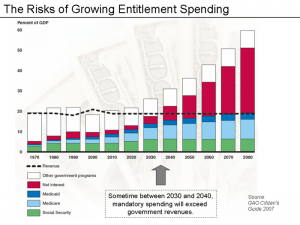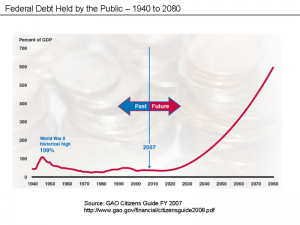USA National Debt will be the talk of the hallways of our nation’s Capital this summer. Why? Well, this past May, the USA government hit its ceiling on how much the Treasury can borrow to pay its bills – debt, pensions, services, and all of its employees including solders. The Treasury bought some time and has indicated that the US will be forced to default if the ceiling isn’t raised by August 2, 2011.
And although the discussion will include all the pitfalls of defaulting on all of the US obligations if the debt ceiling isn’t raised, the discussions will also include the hazards of not addressing the USA national debt. In May, the total public outstanding USA national debt was $14.32 trillion and 98% of the 2010 Gross National Product.
So, what does this mean and what exactly is the USA National Debt? The $14.32 Trillion includes debt held in both “securities” (such as banknotes, bonds, etc.) held by institutions or individuals outside the United States Government and “intergovernmental holdings” representing securities held in accounts administered by the US government (such as OASI Trust fund/social security). The total USA national debt includes these above moving parts.
Ok, but what does it mean? The USA national debt equates to roughly $44,900 in debt per US citizen or $91.500 per member of the US workforce. In 2008, the US government spent $243 billion on interest payments alone (which was approximately 10% of tax revenue collected that year.)
If you look back in history, the largest spikes in the increase in the USA national debt would be during war time – the American Revolutionary War, Civil War, World War 1, and World War II. This makes sense. But with rapid growth of entitlement programs, ongoing wars, and the increase reliance in foreign governments to pay the USA national debt, many economist and government agencies believe we have hit a wall. The US national debt is rising to a point of a fiscal crisis.
According to several government agencies (including the Government Accountability Office, the Congressional Budget Office, and the Office of Management and Budget) and economist who analyze budget and debt data, the USA national debt is leading to a critical long-term financial crisis.

These agencies have indicated that if significant attempts to close the deficit are not undertaken, the USA national debt will increase rapidly due to inflation and entitlement programs (such as Medicare and Medicaid.) According to the Government Accountability Office, the USA national debt to Gross National Product ratio will double by 2040 and double again by 2060, reaching 600 percent by 2080 if drastic actions are not taken. Some economist indicate the US government and its citizens must choose between bankruptcy, raising taxes, or cutting the ever-growing payment obligations of entitlement programs.
The USA national debt is at a critical point. If you want to express concerns about this issue, join the effort to cut spending and cut the USA national debt.

Originally published: http://debtwall.org/usa-national-debt-a-national-crisis/